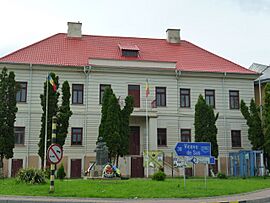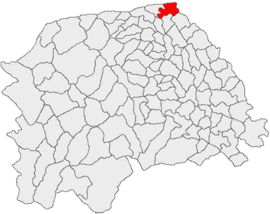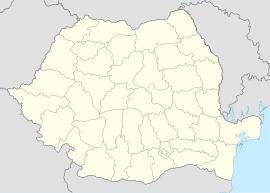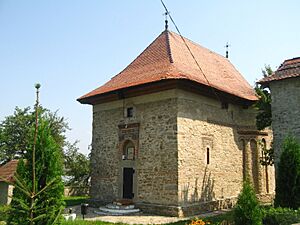Siret facts for kids
Quick facts for kids
Siret
German: Sereth
|
||
|---|---|---|

Former Siret town hall
|
||
|
||

Location in Suceava County
|
||
| Country | ||
| County | Suceava | |
| Area | 43.40 km2 (16.76 sq mi) | |
| Elevation | 324 m (1,063 ft) | |
| Population
(2011)
|
Lua error in Module:Wd at line 1,575: attempt to index field 'wikibase' (a nil value). | |
| Time zone | EET/EEST (UTC+2/+3) | |
| Postal code |
725500
|
|
| Area code | (+40) 02 30 | |
Siret is a town in northeastern Romania, located in Suceava County. It's a very old town and was once the capital of the medieval Principality of Moldavia in the late 1300s. Today, Siret is the 11th largest town in its county, with about 6,700 people living there according to the 2021 census. The town also includes two smaller villages called Mănăstioara and Pădureni.
Contents
Exploring Siret's Location
The town of Siret is found at the very edge of Suceava County, in the northeast of Romania. It's only about 2 kilometers away from the border with Ukraine. This makes Siret an important place for people and goods to cross between Romania and Ukraine.
Border Crossing and Railways
Siret has special places for both cars and trains to cross the border. The Vicșani railway station, located west of Siret, is where trains are checked when they cross into Ukraine. Trains in Romania use a standard track width, but in Ukraine, they use a wider track. Siret is one of the few places in Romania that has special equipment to change the train wheels or move goods, so transportation can continue without problems.
Rivers and Roads
Siret is located on the right bank of the Siret River. It sits about halfway between the cities of Chernivtsi (in Ukraine) and Suceava (in Romania). A major road, the European route E85, also passes through the town, making it easy to travel to and from Siret.
A Look at Siret's Past
Siret has a long and interesting history. Between 1211 and 1225, a fortress was built by the Teutonic Knights on a hill near the town. However, this town and its castle were destroyed by the Tatars in 1241.
Early Mentions and Capital City
The first official mention of Siret in historical papers dates back to 1339. It was also mentioned as a "Russian city" in a list from 1370-1390. For a short time in the late 14th century, Siret was the capital of the Principality of Moldavia, which was an important state in the region.
Changes in Rule
In 1770, the Imperial Russian Army took control of Siret. After this, a serious illness spread through the town. From 1775 to 1918, Siret and the rest of Bukovina were part of the Habsburg monarchy (later Austria-Hungary). During this time, many important Ukrainian groups and schools were active in Siret.
World War II and Beyond
During World War II, Soviet troops captured Siret on April 3, 1944. This happened as part of a larger military operation.
Understanding Religions in Siret

Siret has a history of different religious groups living together. In the 13th and 14th centuries, Christian missionaries came to the area. In 1371, a Catholic bishopric (a church district led by a bishop) was set up in Siret, which was the capital of Moldavia at the time. This was an important religious center. However, when the capital moved from Siret to Suceava around 1388, the importance of the Siret bishopric slowly faded.
Jewish Community History
A Jewish community was present in Siret by the mid-1500s. By the early 1900s, many Jewish people in Siret worked in business. From 1912 to 1918, the town even had a Jewish mayor. During World War I, many Jewish families left Siret to escape the fighting, and when they returned, they found their homes damaged.
In 1930, about 2,121 Jewish people lived in Siret, making up 14% of the town's population. However, during World War II, in June 1941, the authorities forced the Jewish people of Siret to leave their homes and move to other places, eventually to a region called Transnistria. In 1944, Soviet troops freed about 460 Jewish people from Siret who were still there. Many of them later moved to Palestine.
Current Religious Groups
Today, most people in Siret belong to the Romanian Orthodox Christian faith. There are also smaller groups of Roman Catholics, Pentecostals, Greek-Catholics, and other Evangelical Christians.
Siret's Population Over Time
| Historical population | ||
|---|---|---|
| Year | Pop. | ±% |
| 1910 | 7,948 | — |
| 1930 | 9,905 | +24.6% |
| 1948 | 8,058 | −18.6% |
| 1956 | 5,664 | −29.7% |
| 1966 | 8,018 | +41.6% |
| 1977 | 8,264 | +3.1% |
| 1992 | 10,071 | +21.9% |
| 2002 | 9,329 | −7.4% |
| 2011 | 7,721 | −17.2% |
| 2021 | 6,708 | −13.1% |
| Source: Austrian and Romanian census data and/or official estimates | ||
The population of Siret has changed quite a bit over the years. The town had its largest population in 1992, when more than 10,000 people lived there. By the 2021 census, the population was 6,708.
Ethnic Groups in Siret
According to the 2011 census, most of the people in Siret (about 95.85%) are ethnic Romanians. There are also smaller groups of Ukrainians (2.55%), Poles (0.72%), Germans (0.42%), and Russians (0.28%).
Famous People from Siret
Many notable individuals have come from Siret, including:
- Yitzhak Artzi - an Israeli politician
- Elisabeth Axmann - a Romanian-German poet
- Leo Katz - a writer and journalist
- Mykhailo Mykhailyuk Ilkovych - a Ukrainian poet
- Elisabeta Lipă - a famous Romanian rower
- Victorin Ursache - a Romanian archbishop
Siret's Global Connections
Siret is part of a special group called the Douzelage. This is a unique partnership of 24 towns from different countries across the European Union. This program started in 1991 and helps these towns connect through regular events and festivals.
Sister Cities
Siret is twinned with many towns around the world. Being "twinned" means that towns form a special friendship to promote cultural exchange and understanding. Here are some of Siret's sister cities:
 Altea, Spain - 1991
Altea, Spain - 1991 Bad Kötzting, Germany - 1991
Bad Kötzting, Germany - 1991 Bellagio, Italy - 1991
Bellagio, Italy - 1991 Bundoran, Ireland - 1991
Bundoran, Ireland - 1991 Granville, France - 1991
Granville, France - 1991 Holstebro, Denmark - 1991
Holstebro, Denmark - 1991 Houffalize, Belgium - 1991
Houffalize, Belgium - 1991 Meerssen, Netherlands - 1991
Meerssen, Netherlands - 1991 Niederanven, Luxembourg - 1991
Niederanven, Luxembourg - 1991 Preveza, Greece - 1991
Preveza, Greece - 1991 Sesimbra, Portugal - 1991
Sesimbra, Portugal - 1991 Sherborne, United Kingdom - 1991
Sherborne, United Kingdom - 1991 Karkkila, Finland - 1997
Karkkila, Finland - 1997 Oxelösund, Sweden - 1998
Oxelösund, Sweden - 1998 Judenburg, Austria - 1999
Judenburg, Austria - 1999 Chojna, Poland - 2004
Chojna, Poland - 2004 Kőszeg, Hungary - 2004
Kőszeg, Hungary - 2004 Sigulda, Latvia - 2004
Sigulda, Latvia - 2004 Sušice, Czech Republic - 2004
Sušice, Czech Republic - 2004 Türi, Estonia - 2004
Türi, Estonia - 2004 Zvolen, Slovakia - 2007
Zvolen, Slovakia - 2007 Prienai, Lithuania - 2008
Prienai, Lithuania - 2008 Marsaskala, Malta - 2009
Marsaskala, Malta - 2009 Dębica, Poland
Dębica, Poland
Images for kids
See also
 In Spanish: Siret para niños
In Spanish: Siret para niños

















